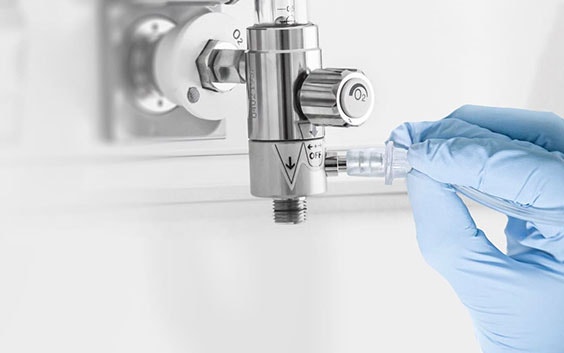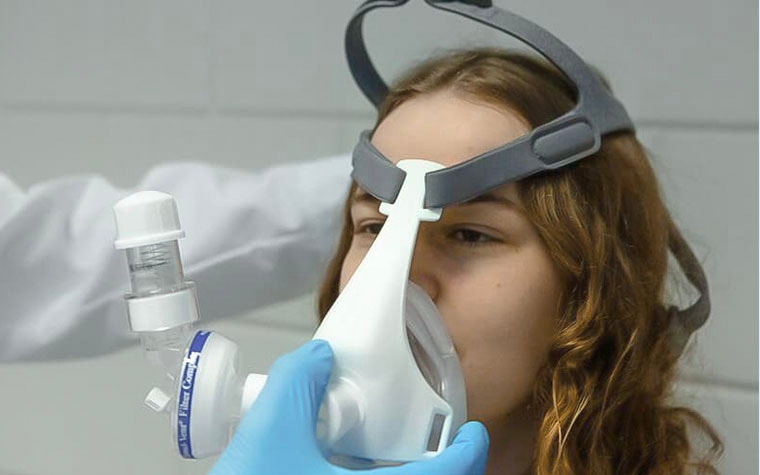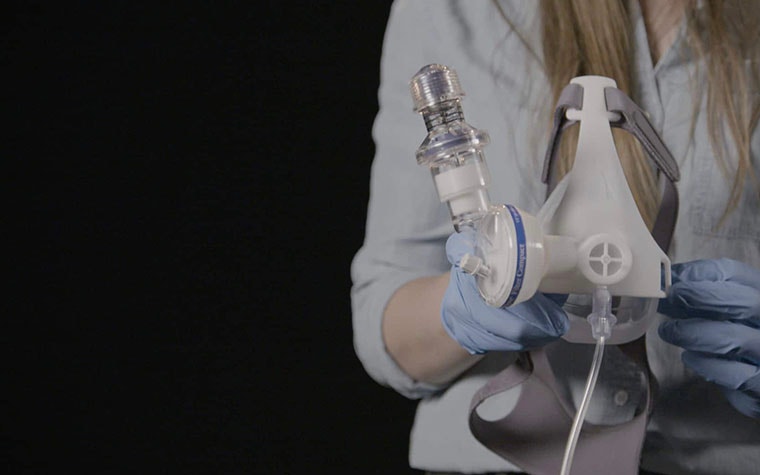CUSTOMER STORY
Passive NIP: “The Genius Is in Its Simplicity” – UZ Leuven

Located in Belgium, one of countries hit hard by COVID-19, University Hospital Leuven (UZ Leuven) is one of the many hospitals working tirelessly on the frontline of the pandemic. The teams there have been faced with the difficult circumstance of treating critically ill patients, all while trying to reduce the risk of also catching the disease.
As patients are facing severe respiratory issues, the hospital has taken a role in leading a clinical trial on a new, easy-to-use solution that bridges the gap between a simple oxygen mask and intubation. Earlier this month, we released the Materialise Passive NIP, with NIP standing for non-invasive PEEP (positive end-expiratory pressure). The idea behind the solution is that it can deliver a combination of oxygen and high-pressure with the aim that it could push back the fluids in the lung and allow for a better uptake of oxygen in the bloodstream.
We’re pleased to hear UZ Leuven has recently treated their first patients with the Passive NIP. Through the treatment they’ve confirmed: the mask is simple, valuable to patients, and the combination of the filter and tight seal may reduce the risk of spreading aerosols.


Straightforward to install and easy to use
Guided by Materialise’s three decades of engineering for 3D printing, in addition to know-how in medical device design and the regulatory process, our medical engineers worked together with doctors to create the non-invasive solution by designing a 3D-printed connector that holds together standard medical equipment, namely a mask, an air filter, and a PEEP valve.
“The genius is in its simplicity,” according to Prof. Arne Neyrinck, Anesthesiologist at UZ Leuven. “The NIP solution consists of commonly available components, which makes it straightforward to install and easy to use.”
To set-up, the medical team just needs to hook it up to an oxygen source, and the positive pressure at the end of the exhalation, also known as PEEP, is created by the design of the mask itself.
“The NIP solution consists of commonly available components, which makes it straightforward to install and easy to use.”
— Prof. Arne Neyrinck, UZ Leuven
PEEP is important for patients with acute respiratory failure, as this positive pressure keeps the airways open, allowing the lungs to take in more oxygen. For these patients, for example, because of a COVID-19 infection, PEEP can assist in improving oxygen saturation.
The solution is easy for his team to set up and starts to work immediately: “You only have to apply the mask, adjust the desired PEEP level, and that’s it. The mask generates the PEEP itself. There is no need for complex calculations. And since the NIP solution works with oxygen flows between 5 and 15 L/min, it can be applied in any standard hospital room which has an oxygen supply.”


Valuable for multiple types of patients
Prof. Neyrinck finds that the NIP solution can be valuable for multiple types of patients. “On the one hand, it can provide support to patients who have been recently weaned off invasive ventilation to potentially discharge them from the ICU facilities a day sooner,” he says. “And on the other hand, it could be used for patients who show low oxygen saturation but don’t necessarily have to be treated in an intensive care unit.”
In these cases, the non-invasive nature of the solution is significant as “the NIP solution has the potential to reduce the average stay of patients in ICU facilities, both before and after applying invasive ventilation.”
Prof. Neyrinck and the nursing staff also had positive feedback on the fit of the mask itself on patients. He noted that the straps and mask are comfortable, and that it has a nice, soft texture and seals well.
Reducing contamination risk
As the World Health Organization has published, there is a possibility to transmit COVID-19 if you breathe in the virus while being within a meter of someone infected. “There is a high risk for aerogenic contamination of health workers in COVID-19 facilities, especially through the spread of the larger aerosols,” as Prof. Neyrinck confirms.
The Passive NIP includes a filter in combination with a tight seal of the mask is intended to reduce the spread of aerosols.
In addition to using non-invasive devices, the WHO recommends using specific personal protective equipment.
Clinical validation is key
In addition to UZ Leuven, Materialise is currently working with hospitals on post-market clinical trials for additional guidance regarding optimal usage. In parallel, we have made the connector itself commercially available in select European countries, called the Materialise NIP Connector, for hospitals in dire need, to provide this as an emergency solution in compliance with local regulation.
Through solutions like these, we will continue to stand behind our commitment to create a better and healthier world. During this time, collaboration is truly more important than ever to help as many patients as possible in the short term with a view to creating solutions that can make a difference to the medical field in the long run. We invite you to join us on our journey.
Materialise NIP Connector is not commercially available in the United States
L-101170-01
Share on:
You might also like
Never miss a story like this. Get curated content delivered straight to your inbox.
